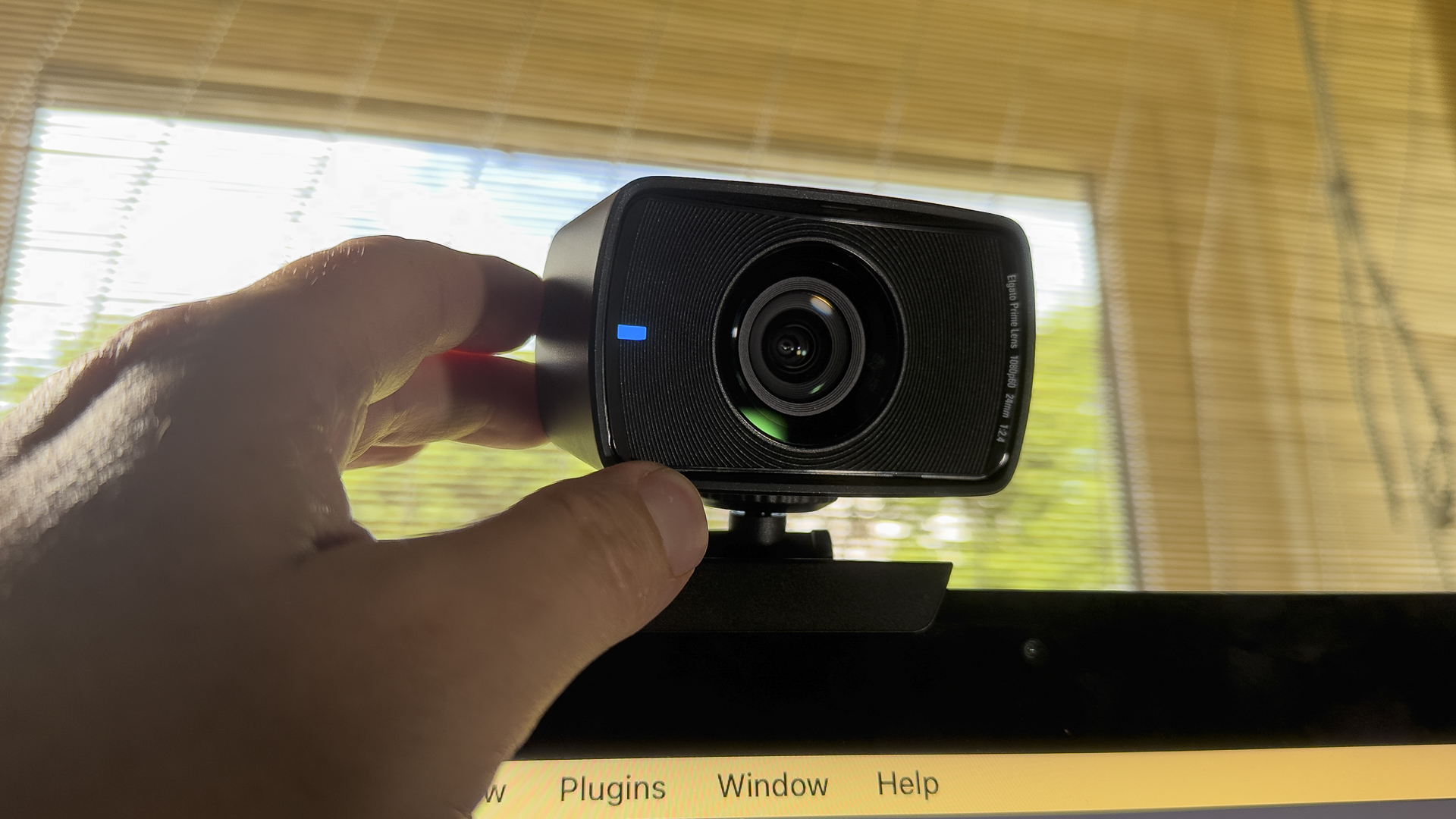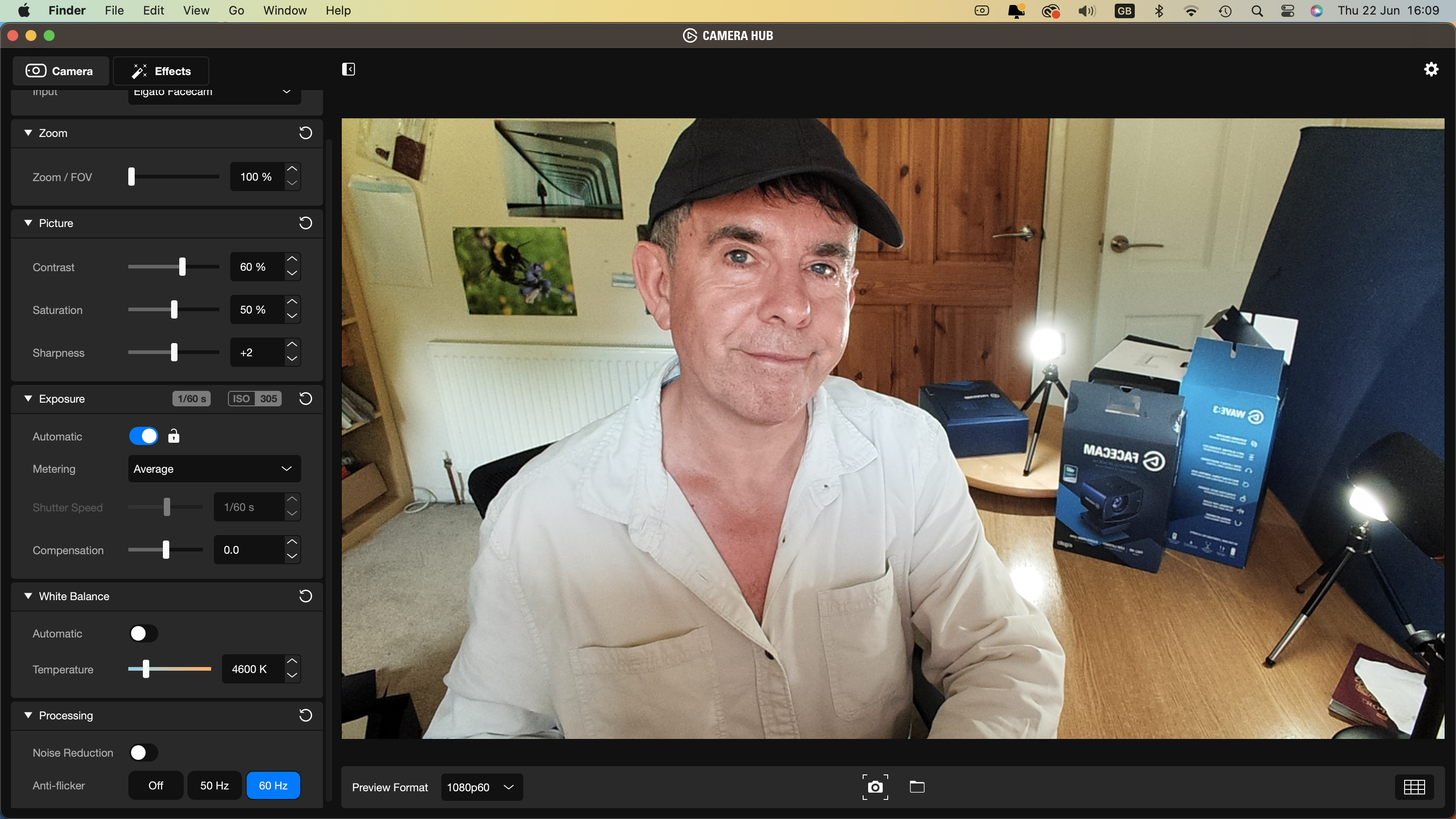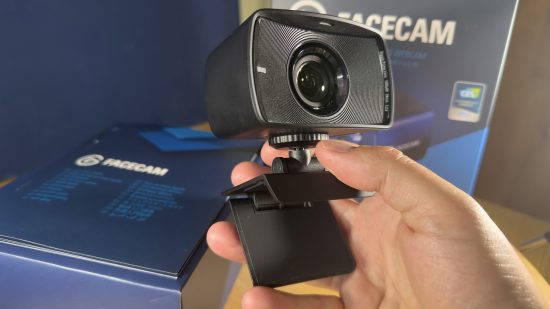Our Verdict
If you want to elevate the visual production values of your online presence the Elgato Facecam will certainly do the trick. It produces high-quality full HD that boasts accurate color rendering and a 60 fps smooth motion. The supporting app enables you to tweak things to fine-tune your stream’s look, for a professional upgrade to most built-in webcams.
- 24mm lens captures a wide angle
- Wide f2.4 aperture (so good in low light)
- Anti-reflective
- Plastic body feels cheap
In the online world of streaming gaming content, we face a lot of competition to be seen and heard. One way to stand out from the streaming crowd is to present yourself more clearly with a higher-quality video feed.
Most PCs have a built-in web camera that tends to have a small lens, leading to fuzzy-looking images with flat tones and washed-out colors. In low light, your video feed can also be plagued with artifacts such as image noise and compression. I used a 2017-era iMac to test the Elgato Facecam for this review – it’s compatible with Windows 10 and macOS 11.0 onwards.
The iMac’s built-in FaceTime HD webcam is something I’ve taken for granted for years, but compared to the results produced by the Elgato Facecam the iMac’s FaceTime footage looks soft and dull. The iMac’s webcam only streams at the smaller HD setting of 1280 x 720 whereas the resolution of the Facecam is a full HD size of 1920 x 1080. The Facecam is superior in other ways too, but is it one of the best webcams?
Why you can trust our advice ✔ At PCGamesN, our experts spend hours testing hardware and reviewing games and VPNs. We share honest, unbiased opinions to help you buy the best. Find out how we test.
Elgato Facecam specs
Elgato Facecam specs:
Elgato Facecam features
A camera is only as good as its lens and the Elgato Facecam’s lens is something special. Unlike some plastic webcam lenses, the Facecam’s lens is constructed from glass. There are 8 glass elements in the lens to ensure a professional-looking image that’s nice and sharp and has a wide range of tones and accurate colors.
The lens’s aspherical surface maximizes image perimeter sharpness – which means it doesn’t blur the image around the edges like lower-quality lenses can. The low dispersion surface of the glass reduces the presence of chromatic aberration (color fringing) that you get with inferior lenses. It also ensures that there’s no tint or color distortion.
In the unlikely event of infrared light being aimed at the camera, the Elgato Facecam’s IR Cut Filter will block infrared light from disrupting the sensor. The Lens also has anti-reflective coatings that preserve image detail and prevent the appearance of image-obscuring lens flare if a light source shines into the camera during a stream.
The USB 3.0 interface transfers uncompressed video with very low latency (delay), so your stream’s audience will be able to interact with you without any video lag. At 60 frames per second, your streaming footage will be life-like and smooth, helping your audience to experience your presence more clearly. Oh, and the Facecam also sports a removable ‘privacy cap’(that’s a lens cap in old money), so you can obscure the web’s view of your room when you’re not streaming.

Design
The Elgato Facecam’s compact black plastic body blended perfectly with the black rim of my iMac’s screen when I perched it on top via the camera’s built-in adjustable clamp. The clamp has rubber padding which helps it get a firm grip on your monitor without scratching it. This rubber clamp means the camera won’t slide about during a stream. An adjustable hinge means that you can angle the camera to capture the best view of your face.
The smooth rounded curves of the Facecam complemented the curved edges of my 2017-era iMac, making it look like a natural extension of my machine. The Facecam is compact enough to fit into the palm of your hand so it doesn’t stand out too much when clamped on top of your PC’s monitor. A generously long USB cable means you could attach the Facecam to an accessory such as the Elgato boom arm, which would give you more choice in where to position it. On the downside, we found that with the Facecam mounted on top of our computer’s display, we had to deliberately look up to make ‘eye contact’ with our followers and subscribers.

Performance
To test the Elgato Facecam we did a test stream alongside a couple of other webcam streaming solutions. As we mentioned in the introduction, our iMac’s built-in FaceTime camera produced a far inferior image to that streamed by the Facecam with color, tone, and all-around clarity. The iMac’s fuzzy footage had the minimum HD quality of 1280 x 720, whereas the resolution of the Facecam is a full HD size of 1920 x 1080. The Facecam streamed at a far smoother 60 fps than the built-in iMac’s 30 fps. So all in all the Elgato Facecam kicked sand in the face of the iMac’s FaceTime camera.
However, if you own an iPhone such as the iPhone 14 Pro Max you can stream that directly into your Mac as an alternative to the built-in FaceTime camera, enabling you to take advantage of the iPhone’s superior lens. You can also use the iPhone’s Portrait mode to blur the background. This hides clutter and lets people focus on your face. The iPhone footage is even sharper and cleaner than that produced by the Elgato Facecam, but to be fair the iPhone is far more expensive.

You can modify various properties of the Elgato Facecam using the free Camera Hub app. The enables you to control the Facecam like you would a DSLR camera through its menu. You can tweak things such as sharpness, saturation, and contrast. You can also make it more or less sensitive to your location’s lighting by adjusting ISO speed and shutter speed too. In our screen grab we’ve manually warmed up the White balance’s color temperature for a warmer more friendly look. If you have a slow web connection you can always drop the framerate of the Facecam from 60 to 30. Once you’ve used the app to personalize the look being streamed you can save the settings directly to the Facecam’s flash memory drive.

You can then pop the Facecam on another streaming device and your personalized look will stream with consistency. The Camera Hub even enables you to reduce the flickering of certain light sources using 50 Hz or 60 Hz buttons. There’s also an intriguingly named Effects button, but this simply gives you the option to flip the screen vertically or horizontally. On the downside, we couldn’t get our adjustments to save to the camera, but we were more than happy with its default settings anyway.
Should you buy the Elgato Facecam?
- Yes: The Elgato Facecam enables you to stream higher quality video than most PC built-in webcams
- Yes: You can adjust the camera angle to keep you in the picture
- No: If you’re a Mac user and have an iPhone then you can stream better footage from that device.
Verdict
If you want to elevate the visual production values of your online presence then the Elgato Facecam will certainly do the trick. It produces high-quality full HD that boasts accurate color rendering and a 60 fps smooth motion. The 24mm lens produces a wider (82º) field of view than our test iMac’s built-in FaceTime camera could.
The supporting Camera Hub app enables you to tweak color, tone, and composition to fine-tune your stream’s look. All in all, the Facecam provides a professional upgrade to built-in webcams thanks to its superior hardware and software features.
If the Elgato Facecam isn’t for you
To complete your streaming setup, check out our list of the best gaming microphones.
